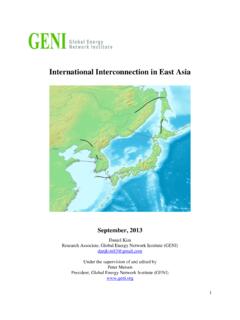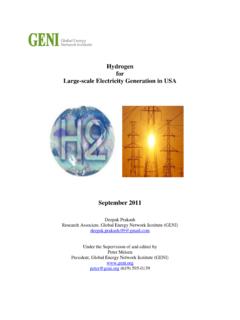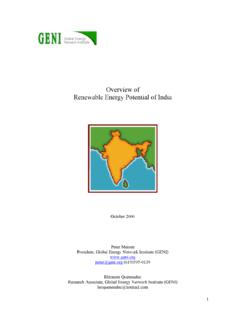Transcription of Renewable Energy Potential of China: Making the ... - GENI
1 Renewable Energy Potential of China: Making the Transition from Coal-Fired Generation Peter Meisen President, Global Energy Network Institute (GENI). (619) 595-0139. Steffanie Hawkins Research Associate, Global Energy Network Institute (GENI). Table of Contents Executive Summary 3. Current Energy Patterns 5. Consumption & Generation 5. Coal 7. Oil & Petroleum 10. Natural Gas 12. Renewable Energy 13. Hydropower 14. Nuclear 15. Geothermal, Solar, Wind & Biomass 16. National Grid 17. Renewable Energy Potential 19. Hydropower 19. Wind 20. Solar 24. Biomass 27. Concluding Remarks 30. 2. Executive Summary China is one of the world's fastest growing countries in multiple aspects. China possesses enormous Potential for the development of Renewable Energy . The government has recently set targets to be reached by 2010 and 2020 for installed generating capacity.
2 The two main sources of Renewable Energy for China will be from hydropower and wind power. Hydropower (China accounts for 12% of world hydropower) is expected to reach a capacity of 190 GW by 2010 and 300 GW by 2020. Wind, the other large source of Renewable Energy , is expected to reach 10 GW by 2010 and 30 GW by 2020. Biomass is expected to reach a capacity of GW by 2010 and 30 GW by 2020. Solar is expected to reach 300 MW by 2010 and GW by 2020. These are reasonable goals for China, but there still remains more Potential for the country. This Potential is against a backdrop of significant need for renewables. In 2006, China became the world's largest polluter passing the US, emitting 6,200 million tons of carbon dioxide. According to the Energy Information Agency (EIA), in 2004, China accounted for 17% of world total carbon dioxide emissions, with an expected increase to 40% of the world total between 2005 and 2030, if current Energy trends continue.
3 China is the world's largest producer and consumer of coal, accounting for 69% of China's total Energy consumption. The EIA reports that as of 2005, China had 28,000 coal mines and was adding a new 500-megawatt coal fired power plant every four days, adding up to approximately 91 new coal-fired power plants a year. This is an aggressive number of plants to open every year. Not only is coal the largest contributor of carbon dioxide but also has several known health effects. In 2009, China Daily reported that every 30 seconds babies are born with defects, totaling almost one million cases a year. The highest rates of birth defects are in Shanxi province, China's largest coal-mining center producing 630. million tons of coal in 2007. Lung cancer in China has also gained public attention as deaths due to lung cancer have risen 465% over the past 30 years.
4 In April 2008, the Chinese Ministry of Health reported that the rise in deaths of lung cancer was directly related to environmental consequences as well as lifestyle. Because of these and several other reasons, it is essential that the Chinese government begin the shift to Renewable Energy and away from coal-fired electricity generation. 3. In China's 10th five-year plan, 2001 to 2005, the Chinese government set goals to increase installed capacity of Renewable Energy . Overall, the plan was moderately successful in promoting Renewable Energy , and it increased installed capacity almost 25%. As of 2007, hydroelectric accounted for of total Energy capacity; nuclear accounted for ; geothermal, solar, wind, and biomass combined only accounted for of Energy capacity. Conventional thermal remained the largest source by far, accounting for of installed capacity.
5 China is a world leader in hydropower development, in terms of both project size and generating capacity, with the world's largest hydropower station along the Yangtze River. Hydropower remains the government's top priority in developing Renewable Energy , because the technology is well developed, and China is relatively experienced in the area. While China's goal remains at 300 GW by 2020, the World Watch Institute projects that China has a Potential of 500 GW of generating capacity. Wind is expected to become China's second largest source of Renewable Energy in China. Since the first wind farm project in 1990, China has seen considerable increase of installed generating capacity and is expected to double this capacity in 2009. While the current goal remains at 30 GW by 2020, the National Renewable Energy Laboratory of the Chinese Academy of Meteorological Sciences estimates that China has a Potential of 235.
6 GW of generating capacity on mainland China, with larger Potential offshore. The largest wind resources Potential lies in Inner Mongolia. China is also looking to develop solar power, though not as much emphasis seems to have been given to solar generation. China is the world's largest producer and exporter of photovoltaic (PV) solar cells. As the largest producer of PV cells, it exported almost 95% of those cells to other countries, because the price remained too high to be competitive with other forms of Energy within country. As a result, the government has implemented subsidies to help defray the cost of solar power and plans to increase capacity to GW by 2020. According to Professor Yin Zhiqiang, it is estimated that over 90% of China can support some form of solar power, mainly located in Western China. Another part of solar power in China that is relatively large is solar thermal water heaters (SWH).
7 The market for SWH has exponentially grown over the past decade with an annual production of 13. million square meters in 2004. 4. The last primary source of Renewable Energy in China is biomass. China has an extremely large rural population with a large resource of biomass for Energy . There are approximately 4 billion tons of crop residue and wood fuels used for Energy in rural areas. The government is Making strides to develop and make more efficient use of biomass in rural areas, because the industry is already established. According the Wu and several other scholars, biomass technology in China has a sizeable market Potential in Making use of biomass waste, and it is economically feasible. The development of biomass technology in the areas with the largest supply of biomass waste, the rural areas, will benefit those who need reliable and efficient electricity.
8 The development of biomass in the rural areas is a win-win situation. Current Energy Patterns Consumption & Generation In 2006, China was the second largest consumer of Energy , behind the United States, consuming quadrillion Btu's (Quads), almost double its 2000 consumption. China has experienced an annual growth in consumption of since the late 1950's1. Thus, China's economic engine is doubling Energy demand every 8 years. The total generating capacity includes coal, petroleum, natural gas, nuclear, hydroelectric, and other non- hydroelectric Renewable sources2. 1 Energy consumption in China: past trends and future directions . Energy Economics. Vol 27, Issue 1, Jan 2005, Pp 195-208. 2 International Energy Statistics , Energy Information Administration (EIA), 5. While the amount of Renewable sources is increasing slowly, the use of coal and oil as generation of electricity is steadily increasing and is projected to account for approximately 80% of Energy production by 20303.
9 The level of CO2 emissions within China has also sharply increased within the past decade. In 2004, China was the world's second largest producer of carbon dioxide emissions behind the US. By 2006, China had become the world's largest CO2 emitter, emitting 6,200 million 3 Projected Energy Growth in China by Energy Source Earth Trend 2008, 6. tons, an 8% increase from 20054. The International Energy Agency predicts that if current policy remains unchanged, China will account for 40% of worldwide CO2 emission growth between 2005 and 2030. For this reason, it is essential that the Chinese government begins now to create and implement incentives and policies that will move China toward clean, Renewable Energy sources and away from coal-fired generation. Coal In 2000, China consumed short billion tons of coal; by 2007, it had consumed billion, a 53% increase5.
10 China is the world's largest consumer and producer of coal, 4 Vidal, John and David Adam. China Overtakes US as world's biggest CO2 emitter . 7. accounting for 69% of Chinas total Energy consumption. China is by far the largest coal supplier in the world, producing 46% of the world's total coal supply, a significant increase from 1973 when it only produced 18% of the world's supply6. Source: International Energy Agency While many of the other regions have maintained or reduced levels of coal production, China has shown significant growth in coal production over the past three decades. By the end of 2005, it was reported that China had 28,000 coal mines7. China has been reported as adding a new 500-megawatt coal fired power plant every four days, approximately 91 new power plants a year8. Coal consumption tends to be concentrated in four different industries: power generation, building material, metallurgy and chemical production, power generation being the largest user of coal -- accounting for over 50% of production and consumption9.











